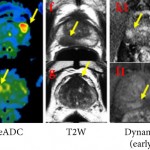Cumulative cancer length in selecting candidates for Active Surveillance: use or abuse?
Sir,
Chen et al. [1] have performed an interesting evaluation on cumulative cancer length on prostate needle biopsy (Bx) divided by the number of biopsy cores (CCL/core) in predicting outcomes after radical prostatectomy (RP) in candidates for Active Surveillance (AS). Criticisms against AS criteria could concern the relevant proportion of upstaging, upgrading or unfavourable cancer in subjects with apparently low- or favourable-risk PCa [2].
To this regard, AS has gained popularity with the intention of avoiding or postponing interventions in subjects with PCa of low biological potential. Characteristics of AS protocols are the use of serum prostate-specific antigen (PSA) measurement, clinical evaluation through performance status and digital rectal examination, magnetic resonance imaging analysis and pathologic bioptical examination. In this multidisciplinary setting, it is obvious that although AS could benefit some patients, the risk of misclassification still persist in others. In the updated results from the Prostate Cancer Research International: Active Surveillance (PRIAS) study, 27% of the cohort experienced disease reclassification (defined as Gleason score >6 and/or more than positive cores) at repeated biopsy during follow-up [3].
According to a recent comparison of several contemporary protocols, the PRIAS study showed the highest ability to identify patients with organ-confined low-grade cancer, with an AUC of 0.62 [4].
In this context, various morphometric measurements of cancer extent on needle prostatic biopsies have been proposed in order to improve selection for AS and RP outcomes may provide a surrogate for protocol performance.
Efforts are currently being made by researchers to optimize selection criteria, expand indications, and search for accurate tools that may help reduce the initial misclassification of aggressive disease. One of the most easily obtainable measurements of biopsy tumor extent is the CCL, or similarly the CCL/core, as a new pathological feature of prostate biopsy [5]. In the study by Chen et al. [1], a cut-off of CCL/core ≥0.20 mm was significantly associated with insignificant cancer at the univariate logistic regression analysis but not at the multivariate. CCL/core ≥0.20 mm was found to be associated with low-volume organ-confined disease (LV-OCD) defined as pT2 PCa with RP Gleason score ≤ 3+4=7 and volume <0.5 mL.
However there could be a bias in either the enrolment of patients with Bx Gleason score ≤ 3+4=7 (not eligible for current AS protocols) or insufficient of validation of the AS criteria applied.
It should be noted that different criteria have been used to define “unfavourable” disease, but a Gleason score of 7 may represent a “significant” cancer.
Moreover, if a potential predictive factor may be considered potentially efficient, it should improve a pre-existing model and be compared to it. To this regard, although not statistically demonstrated by receiver operating curve analysis, the accuracy of the model for predicting LC-OCD (using number of positive cores 1 vs. 2, Max % core involvement <50, and CCL/core <0.20 mm) in patients with Bx Gleason score 3+3=6 was lower than model not using CCL/core <0.20 mm).
In a recent article that we published, we demonstrated that adding to PRIAS criteria the percentage of cancer involvement in positive cores (CIPC) ≥ 0.4 mm, calculated by dividing the cumulative cancer length (CCL) to the cumulative length of positive cores (CLPC), significantly improved the ROC analysis from 0.61 to 0.94 [6].
Before suggesting current AS protocol to include CCL to the criteria we would offer some suggestions. First of all, differences still exist about its definition. We would underline that dividing the CCL to the cumulative length of positive cancer, defined as CIPC, and not to the number of biopsy cores, could be more suitable for identifying a significant PCa, due to its better “mathematical” definition.
Furthermore, observational protocol-based AS studies may be more helpful by analyzing the risk of misclassification at the second biopsy and by comparing CIPC and CCL/core. We can officially give the acceptance of CCL/core or CIPC only consolidating the AS criteria and the definition of “significant” PCa.
At this time we do not discourage patients from AS until CCL use or abuse is unveiled.
Conflict of Interest
None declared
Giorgio Ivan Russo1*, Giuseppe Morgia1
1Department of Urology, University of Catania, Italy
*Correspondence: Dr. Giorgio Ivan Russo, M.D., Department of Urology, University of Catania, Italy.
Tel. +39 (95) 3782712; fax +39 (95) 3782373; e-mail: [email protected]
References
- Chen DJ, Falzarano SM, McKenney JK, et al. Does cumulative prostate cancer length in prostate biopsies improve prediction of clinically insignificant cancer at radical prostatectomy in patients eligible for active surveillance? BJU Int 2014; doi: 10.1111/bju.12880
- Kates M, Tosoian JJ, Trock BJ, Feng Z, Carter HB, Partin AW. Indications for intervention during active surveillance of prostate cancer: a comparison of the Johns Hopkins and Prostate Cancer Research International Active Surveillance (PRIAS) protocols. BJU Int 2014; doi: 10.1111/bju.12828
- Bul M, Zhu X, Valdagni R, et al. Active surveillance for low-risk prostate cancer worldwide: the PRIAS study. Eur Urol 2013; 63: 597-603
- Iremashvili V, Pelaez L, Manoharan M, Jorda M, Rosenberg DL, Soloway MS. Pathologic prostate cancer characteristics in patients eligible for active surveillance: a head-to-head comparison of contemporary protocols. Eur Urol 2012; 62: 462-8
- Komai Y, Kawakami S, Numao N, et al. Extended biopsy based criteria incorporating cumulative cancer length for predicting clinically insignificant prostate cancer. BJU Int 2012; 110: E564-9
- Russo GI, Cimino S, Castelli T, et al. Percentage of cancer involvement in positive cores can predict unfavorable disease in men with low-risk prostate cancer but eligible for the prostate cancer international: active surveillance criteria. Urol Oncol 2014; 32: 291-6


